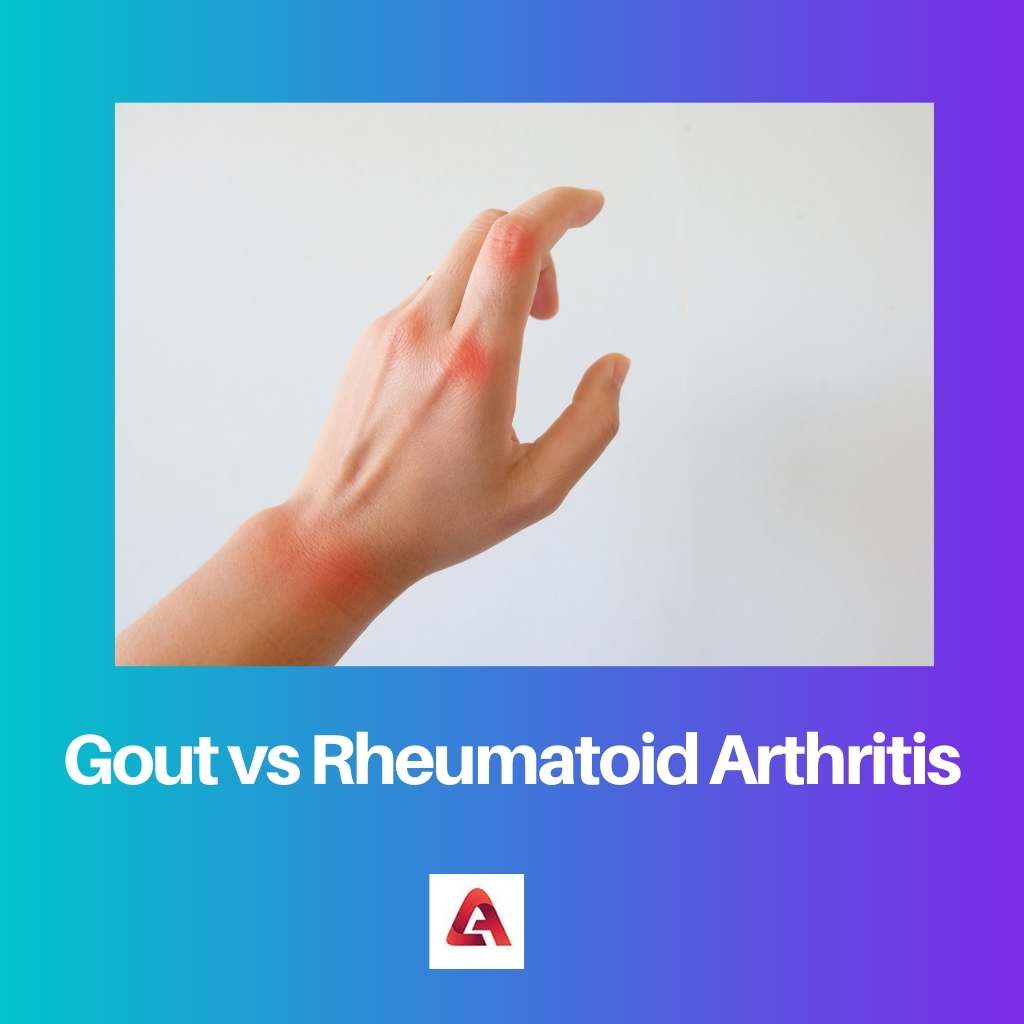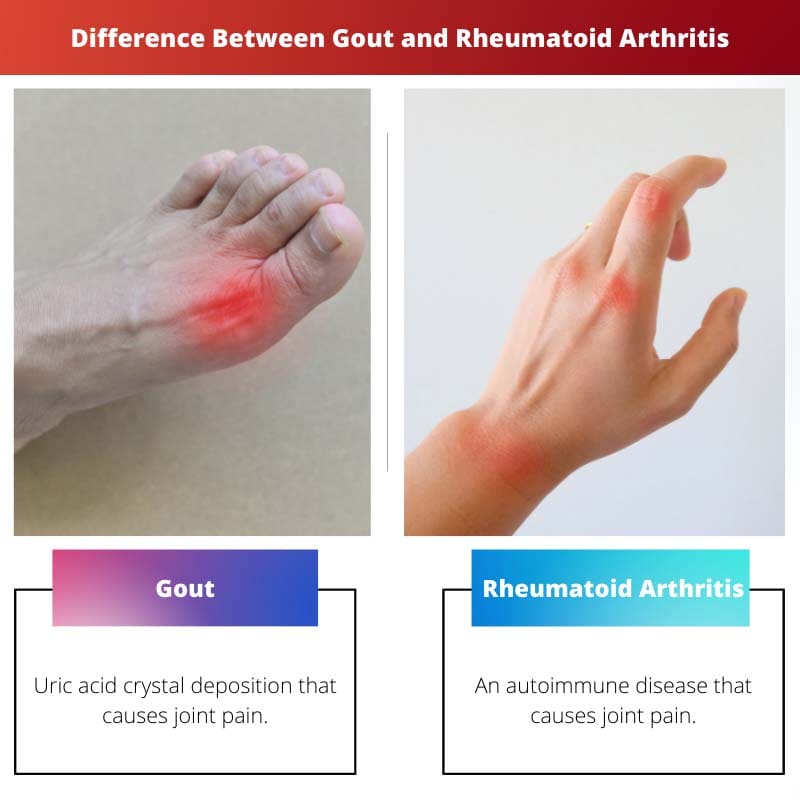Gout and rheumatoid arthritis are both inflammatory disorders that cause joint discomfort and swelling. Inflammation is a natural protective mechanism that promotes recovery.
When the body identifies an invader, it initiates a biological reaction in an attempt to eliminate it. The body can sometimes wrongly view its own cells or tissues as dangerous, which can cause an inflammatory disorder.
Key Takeaways
- Gout results from uric acid crystal accumulation in joints, while rheumatoid arthritis stems from an autoimmune response attacking joint linings.
- Gout affects one joint at a time and starts in the big toe, whereas rheumatoid arthritis impacts multiple joints symmetrically.
- Specific foods and alcohol can trigger gout attacks, while rheumatoid arthritis flare-ups are less predictable and related to immune system activity.
Gout vs Rheumatoid Arthritis
Gout is a type of arthritis caused by a buildup of uric acid crystals in the joints, affecting one joint at a time and starting in the big toe, and can also affect other joints such as the ankle, knee, or elbow. Rheumatoid Arthritis is an autoimmune disease that causes inflammation in the joints.

Gout is a kind of arthritis characterized by an overabundance of uric acid in the joints. Gout is a severe form of arthritis that affects the foot’s big toe joint.
It can also infiltrate the big toe and around the ankle. On rare occasions, it also affects other parts of the body.
Rheumatoid arthritis is an autoimmune condition that affects the knee joints. The actual etiology of the ailment is unknown. However, it is thought to be an issue with the immune system attacking the joints.
Both genetic and environmental factors have a part in the development of the condition.
Comparison Table
| Parameters of comparison | Gout | Rheumatoid Arthritis |
|---|---|---|
| Meaning | Uric acid crystal deposition that causes joint pain | An autoimmune disease that causes joint pain. |
| Risk Factor | Kidney disease, hypertension, and diabetes can increase the chances of development. | Overweight females and smokers are at a higher risk. |
| Complications | It can result in tophi and kidney stones. | It can result in heart disease, weight gain, and diabetes. |
| Treatment | The symptoms can be treated by using colchicine and anti-inflammatory medicine. | The symptoms can be treated using hydroxychloroquine, heat therapy, and movement exercises. |
| Duration | Gout treatment can last for 5 to 7 days. | Treatment can take anywhere from 4 weeks to 3 months. |
| Diagnosis | By testing Uric acid crystals present in the synovial fluid of the joint. | By testing the anti-CCP antibodies present in the bloodstream. |
What is Gout?
Gout is a severe form of arthritis that affects the foot’s big toe joint.
Gout was dubbed the “arthritis of the rich” by the Greek philosopher-physician Hippocrates because it was historically connected with indulgence in rich food and wine.
The most noticeable signs are pain, red and swollen joints. The big toe is the most commonly affected joint, although gout can affect many other joints, including the ankles and wrists.
A physical exam may imply gout, but it is best verified by collecting a sample of fluid from the afflicted joint’s synovial cavity.
If gout is the source of the disease, uric acid will be found in the fluid. Ultrasound and X-rays can sometimes reveal lesions on the bone that indicate gout.
Gout is caused mostly by the kidneys’ failing to operate effectively and eliminate uric acid. Certain medical diseases can also cause an accumulation of uric acid.
Some kinds of blood malignancy and hemolytic anemia, for example, can induce the illness.
Having a renal illness, being diabetic, being hypertensive, or having high blood cholesterol levels are all risk factors for acquiring the syndrome.

What is Rheumatoid Arthritis?
Rheumatoid arthritis is an autoimmune illness. It happens when the body’s immune system kills healthy cells in the synovial tissues or joint linings by mistake.
Inflammation, stiffness, soreness, and swelling of the joints are all symptoms of rheumatoid arthritis. If left unchecked, it might cause lasting damage and reduce your well-being.
Rheumatoid arthritis is a systemic illness as well. This implies that it can have an impact on other organs in the body, such as the eyes, skin, lungs, and heart.
People who have rheumatoid arthritis are more prone to developing cardiovascular disease than those who do not.
Women between the ages of 35 and 50 who are also overweight are most likely to develop rheumatoid arthritis.
The symptoms include stiff and aching joints that worsen in the morning or after a lot of exertion. Joints on both sides of the body are frequently affected and may be enlarged.
The person may also feel nervous and have a little fever.
Rheumatoid arthritis most commonly affects the joints of the arms, legs, hands, and feet. Another common symptom is that the same joint on both sides of the body, such as the left and right hands, is affected.

Main Difference Between Gout and Rheumatoid Arthritis
- Gout is caused by uric acid crystals forming in the joints. The joints are targeted by immune system cells in rheumatoid arthritis.
- Gout is more common in males, whereas rheumatoid arthritis is two to three times more common in females than in males.
- Gout rarely affects joints on both sides of the body. Rheumatoid arthritis frequently affects symmetrical joints.
- Morning stiffness of the joints is not common in gout patients, whereas rheumatoid arthritis patients frequently experience morning joint stiffness.
- Gout causes redness, swelling, and intense pain. On the other hand, rheumatoid arthritis pain can be slight, moderate, or severe, and it is accompanied by stiffness.
- Gout commonly strikes people between the ages of 30 and 60. Rheumatoid arthritis manifests itself in people in their 60s, although it can occur at any age.




